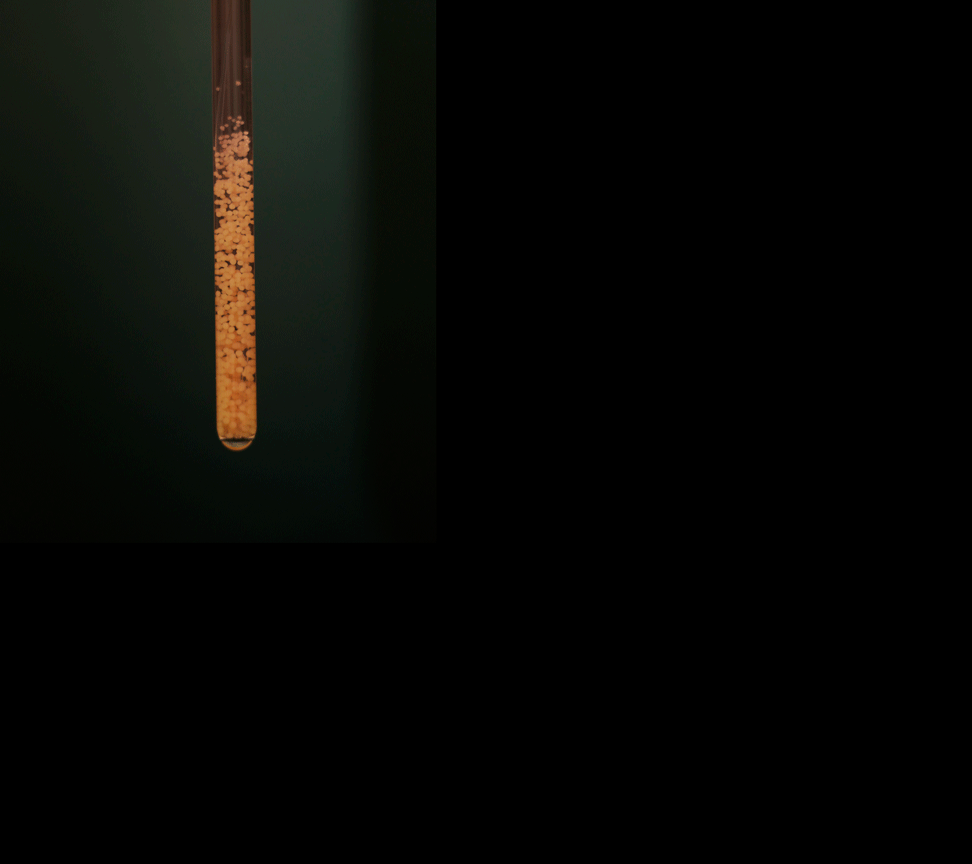Our team
BioRxn LLC was founded in 2009 as an outlet for bioreactor technology from the laboratory of UNC biomedical engineering professor Jeffrey Macdonald.

Our technology is a fluidized-bed bioreactor that combines alginate-encapsulation with fluidized-bed bioreactor to achieve the world’s densest liver cultures. With diameters of ~400 μm, the alginate-encapsulated tissues mimic the liver to achieve near-in vivo nutrient and oxygen gradients. These preparations can be maintained for months while preserving their Type 1 and Type 2 drug metabolizing functions.
Near tissue density permits physiological concentrations of paracrine factors to accumulate in media, and in conjunction with 31P and 13C NMR can be used to derive physiologically-relevant pharmacokinetic parameters.

Our bioreactors are NMR-compatible for real-time acquisition of bioenergetics and flux measurements. In addition, our platform can be used for standard DMPK studies, supports pulse-chase labeling experiments, and provides exploratory and mechanistic toxicology endpoints
BioRxn’s new 5 mm NMR-compatible bioreactor was created by morphing two bioreactor technologies from Professor Macdonald’s University of North Carolina at Chapel Hill laboratory: (1) Multicoaxial membrane bioreactor and (2) Fluidized-bed bioreactor that maintains the densest 3D alginate-encapsulated hepatocytes cultures ever published.

Macdonald, J. M., Grillo, M., Schmidlin, O., Tajiri, D. T., and James, T. L. (1998). "NMR Spectroscopy and MRI Investigation of a Potential Bioartificial Liver." Nmr Biomed. 11, 55-66. PMID: 9608589
Wolfe, S. P., Hsu, E., Reid, L. M., and Macdonald, J. M. (2002). “A Novel Multi-coaxial Hollow Fiber Bioreactor for Adherent Cell Types. Part I: Hydrodynamic Studies.” Biotech. Bioeng. 77, 83-90. PMID: 11745176
McClelland, R. E., Macdonald, J. M. and Coger, R. N. (2003). “Modeling Oxygen Transport Within Engineered Hepatic Devices.” Biotech. Bioeng. 82(1) 12-27. PMID: 12569620
Seagle, C., Christie, M., Winnike, McClelland, R., J., Ludlow, J. W., O’Connell, T. M., Gamcsik, M. P., and Macdonald, J. M. (2008) “High Through-put Nuclear magnetic Resonance Metabolomic Footprinting for Tissue Engineering.” Tiss. Eng. Part C 14(2): 1-12. Epub 2008 May 1. PMID: 18544027
Chandrasekaran, P., Seagle, C., Rice, L., Macdonald, J. M., Gerber, D. A. (2006). “Functional Analysis of Encapsulated Hepatic Progenitor Cells.” Tissue Engineering 12(7) 1-8.
Dewar, B.J., Keshari, K.R., Jeffries, R.E., Graves, L.M, and J. M. Macdonald (2010). “Metabolic assessment of a novel chronic myelogenous leukemic cell line and an imatinib resistant subline by 1H NMR spectroscopy.” Metabolomics 6:439-450 Epub on-line, March 14, 2010. PMID: 20676217
Keshari, KR, Kurhanewicz, J., Wilson, DM, Jeffries, RE, Dewar, BJ, Van Criekinge, M, Vigneron, DB, and JM Macdonald (2010). “Hyperpolarized 13C spectroscopy and a novel NMR-compatible bioreactor system for the investigation of real time cellular metabolism.” Magn. Reson. Med. 63: 322-329. PMID: 20099325
Jeffries, R.E., Gamcsik, M.P., Keshari, K.R., Pediaditakis, P., Tikunov, A.P., Young, G., Lee, H., Watkins, P.B. and J.M. Macdonald. (2013) “Effect of Oxygen Concentration on Viability in a Fluidized-bed Bioartificial Liver Using 31P NMR Spectroscopy.” Tissue Engineering Part C. Methods. 19(2): 93-100. PMID: 22835003
Lee, H, Jeffries, R.E., Tikunov, A.P., Macdonald (2016). “Chapter 13: Advanced Liver Tissue Engineering Approaches and Their Measure Of Success Using NMR/MRI” in Magnetic Resonance Imaging in Tissue Engineering, Edited by M. Kotecha, R. Magin, J. Mao. Wiley STM. New York, NY.
BioRxn LLC was founded in 2009 as an outlet for bioreactor technology from the laboratory of UNC biomedical engineering professor Jeffrey Macdonald.

Dr. Macdonald brings over 25 years of experience in the metabolomic and bioreactor design field. Dr. Macdonald is a Professor of Biomedical Engineering at the University of North Carolina at Chapel Hill, the Scientific Director of the UNC Metabolomic and Flux Analysis Facility at Chapel Hill, NC and Co-Founder of the NCSU/UNC/NOAA Marine MRI Facility at Beaufort, NC. Dr. Macdonald’s research includes the non-invasive analysis of biological systems by NMR and MRI and the generation of multinuclear NMR metabolomic data at the cellular and systems level, both of which are extremely valuable in understanding the performance of bioreactors in order to optimize their operations. Dr. Macdonald received his Ph.D. from the Department of Pharmaceutical Chemistry at the University of California at San Francisco where he studied biophysical applications of nuclear magnetic resonance spectroscopy (NMR) and imaging (MRI).

Dr. Tikunov is an expert in bioreactor design and construction. Resourceful and proficient, Andrey completed a bachelor’s and master’s degree in physics and biophysics from Moscow State University. Andrey received his PhD in biology from the Hematology Research Center, Russian Academy of Medical Science. Dr. Tikunov has over 10 years of biomedical engineering experience. For the past 4 years he has been working on general organism metabolic regulation using NMR/MRI techniques as a researcher in Cell and Developmental Biology and Biomedical Engineering departments at the University of North Carolina at Chapel Hill.